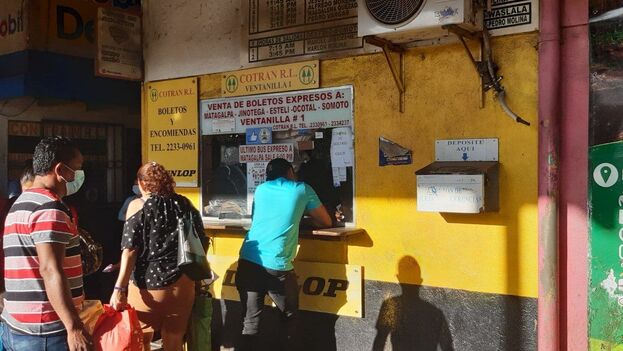EL GRAN EXODO: ESTADOS UNIDOS BATE RECORD HISTORICO CON LA LLEGADA DE 171,080 NUEVOS CUBANOS. PHOTOS.
Cuba, la isla en fuga. El maquiavélico uso de la migración. Las llegadas de cubanos a Nicaragua aumentaron más de un 1.000% con la exención de visados
LA CRISIS MIGRATORIA que sufre Cuba desde finales del año pasado está superando las peores previsiones. Según los datos recién publicados por el Departamento de Aduanas y Protección de Fronteras, en los últimos ocho meses, desde el inicio del año fiscal estadounidense, el 1 de octubre de 2021, han entrado a territorio estadounidense por tierra un total de 140.602 cubanos, una cifra que ya sobrepasa el éxodo del Mariel de 1980, cuando 125.000 personas alcanzaron Estados Unidos en siete meses.
Apenas el pasado abril, los cálculos preveían que al final del presente año fiscal –que termina el 30 de septiembre de 2022–, entrarían en Estados Unidos unas 150.000 personas. Hasta ese mismo abril, 102.168 cubanos fueron detenidos por la Oficina de Aduanas y Protección Fronteriza, la mayoría de ellos tras hacer un viaje por tierra que arrancó en Nicaragua, según contó un alto funcionario de manera anónima al diario The New York Times.
Si, a falta de tres meses para el fin del año fiscal, la tónica se mantiene como el pasado mayo, cuando alcanzaron EE UU más de 25.000 cubanos, el total se elevará por encima de los 200.000, un número inédito. La Administración de Joe Biden es ya, de hecho, la que más cantidad de cubanos ha recibido en la historia: 171.080 desde que comenzó su mandato.
Los números en mayo, bien es cierto, disminuyeron ligeramente, coincidiendo con las primeras conversaciones entre EE UU y Cuba relacionadas con la crisis migratoria y las decisiones de, por un lado, establecer visados de tránsito en terceros países y, por otro, el reforzamiento de la vigilancia en la ruta por México.
En diciembre de 2021, el primero completo con la nueva norma en vigor, llegaron a Managua 6.178 personas originarias de la Isla
Y el “tercer país” por excelencia en la ruta hacia el norte, desde que el mandatario Miguel Díaz-Canel pactó con Daniel Ortega el establecimiento de “visado libre” para los cubanos, el pasado 30 de noviembre, es Nicaragua. Este mismo jueves, el diario nicaragüense El Confidencial publicó datos oficiales que revelan que en diciembre de 2021, el primero con la nueva norma en vigor, llegaron a Managua 6.178 personas originarias de la Isla, un 1.118,5% más que el mes anterior, cuando arribaron 507.
Pero ya el anterior noviembre se notaba el desproporcionado y vertiginoso aumento. La exención de visado entró en vigor el día 22, pero apenas en esos días ya el salto fue igual de considerable pese a que los números no resulten tan impactantes. En octubre habían llegado solo 42 cubanos a Nicaragua, por lo que, un mes más tarde, esos 507 ya mencionados, supusieron un 1.107% más.
Las cifras no hacen sino cuantificar lo que es una evidencia: miles de cubanos huyen a través de lo que ya se conoce como la “ruta de los volcanes” para escapar de la falta de libertades y la siempre crónica, pero agravada, miseria de la Isla. El mandatario nicaragüense Daniel Ortega ha prestado a su socio, el régimen cubano, una base de salida hacia EE UU que, para muchos analistas, cumple el triple objetivo de presionar a Washington para que negocie a cambio de aminorar el flujo de personas que se agolpan en la frontera, servir de vía de escape a una masa de población disconforme que amenaza con estallar contra el régimen y captar divisas a través de los emigrados.
Ahora, con el turismo en mínimos, con la población asfixiada por los altos precios –y muy frecuentemente en divisas– y la frontera estadounidense más abierta a la emigración, los cubanos lo venden todo y huyen vía Nicaragua.
No obstante, el camino ha sufrido complicaciones, ya que no existen vuelos directos entre La Habana y Managua y algunos países empezaron a exigir visado de tránsito, entre ellos Panamá, principal zona de paso gracias a su aerolínea Copa.
THE GREAT EXODUS: UNITED STATES BREAKS HISTORICAL RECORD WITH THE ARRIVAL OF 171,080 NEW CUBANS. PHOTOS.
Cuba, the island on the run. The Machiavellian use of migration. Arrivals of Cubans to Nicaragua increased more than 1,000% with the visa exemption
THE MIGRATORY CRISIS that Cuba has suffered since the end of last year is surpassing the worst forecasts. According to data recently published by the Department of Customs and Border Protection, in the last eight months, since the beginning of the US fiscal year, on October 1, 2021, a total of 140,602 Cubans have entered US territory by land, a figure that already exceeds the Mariel exodus of 1980, when 125,000 people reached the United States in seven months.
Just last April, calculations predicted that at the end of the current fiscal year – which ends on September 30, 2022 – some 150,000 people would enter the United States. Until that same April, 102,168 Cubans were detained by the Customs and Border Protection Office, most of them after making a trip by land that started in Nicaragua, according to a senior official anonymously told The New York Times.
If, with three months to go before the end of the fiscal year, the trend remains as it did last May, when more than 25,000 Cubans reached the United States, the total will rise above 200,000, an unprecedented number. The Joe Biden Administration is already, in fact, the one that has received the largest number of Cubans in history: 171,080 since he began his mandate.
The numbers in May, it is true, decreased slightly, coinciding with the first talks between the US and Cuba related to the migration crisis and the decisions to, on the one hand, establish transit visas in third countries and, on the other, the reinforcement surveillance on the route through Mexico.
In December 2021, the first complete with the new norm in force, 6,178 people from the Island arrived in Managua
And the “third country” par excellence on the route to the north, since President Miguel Díaz-Canel agreed with Daniel Ortega to establish a “free visa” for Cubans, on November 30, is Nicaragua. This same Thursday, the Nicaraguan newspaper El Confidencial published official data revealing that in December 2021, the first with the new regulation in force, 6,178 people from the island arrived in Managua, 1,118.5% more than the previous month, when 507 arrived.
But already the previous November the disproportionate and vertiginous increase was noticeable. The visa exemption came into force on the 22nd, but just in those days, the jump was just as considerable despite the fact that the numbers are not so impressive. In October, only 42 Cubans had arrived in Nicaragua, so, a month later, those 507 already mentioned, accounted for 1,107% more.
The figures do nothing but quantify what is evidence: thousands of Cubans flee through what is already known as the “volcano route” to escape the lack of freedoms and the always chronic but aggravated, misery of the Island. Nicaraguan President Daniel Ortega has lent his partner, the Cuban regime, a base for departure to the United States that, for many analysts, fulfills the triple objective of pressuring Washington to negotiate in exchange for reducing the flow of people who crowd the border, serve as an escape route for a mass of dissatisfied population that threatens to explode against the regime and capture foreign currency through the emigrants.
Now, with tourism at a minimum, with the population suffocated by high prices – and very often in foreign currency – and the US border more open to emigration, Cubans sell everything and flee via Nicaragua.
However, the road has suffered complications, since there are no direct flights between Havana and Managua and some countries began to require a transit visa, including Panama, the main transit area thanks to its Copa airline.
Agencies/ 14yMedio/ Extractos/ Excerpts/ Internet Photos/ Arnoldo Varona/ www.TheCubanHistory.com
THE CUBAN HISTORY, HOLLYWOOD.



 EL GRAN EXODO: Estados Unidos bate Record Historico con la llegada de 171,080 Nuevos Cubanos. PHOTOS. * THE GREAT EXODUS: the United States Breaks Historical Record with the Arrival of 171,080 New Cubans. PHOTOS.
EL GRAN EXODO: Estados Unidos bate Record Historico con la llegada de 171,080 Nuevos Cubanos. PHOTOS. * THE GREAT EXODUS: the United States Breaks Historical Record with the Arrival of 171,080 New Cubans. PHOTOS.





